Ï»¿tell Us What You Know About the Intermolecular Forces in Water.
11.ii: Intermolecular Forces
- Page ID
- 21770
Learning Objectives
- To describe the intermolecular forces in liquids.
The backdrop of liquids are intermediate between those of gases and solids, but are more similar to solids. In contrast to intramolecular forces, such as the covalent bonds that hold atoms together in molecules and polyatomic ions, intermolecular forces concur molecules together in a liquid or solid. Intermolecular forces are generally much weaker than covalent bonds. For example, it requires 927 kJ to overcome the intramolecular forces and break both O–H bonds in 1 mol of water, but it takes but about 41 kJ to overcome the intermolecular attractions and catechumen 1 mol of liquid water to water vapor at 100°C. (Despite this seemingly depression value, the intermolecular forces in liquid water are amongst the strongest such forces known!) Given the big divergence in the strengths of intra- and intermolecular forces, changes between the solid, liquid, and gaseous states virtually invariably occur for molecular substances without breaking covalent bonds.
The properties of liquids are intermediate between those of gases and solids, but are more like to solids.
Intermolecular forces determine bulk backdrop, such as the melting points of solids and the boiling points of liquids. Liquids eddy when the molecules have enough thermal energy to overcome the intermolecular attractive forces that hold them together, thereby forming bubbles of vapor within the liquid. Similarly, solids melt when the molecules acquire enough thermal free energy to overcome the intermolecular forces that lock them into place in the solid.
Intermolecular forces are electrostatic in nature; that is, they ascend from the interaction between positively and negatively charged species. Similar covalent and ionic bonds, intermolecular interactions are the sum of both attractive and repulsive components. Because electrostatic interactions fall off rapidly with increasing distance between molecules, intermolecular interactions are about important for solids and liquids, where the molecules are close together. These interactions become of import for gases only at very high pressures, where they are responsible for the observed deviations from the platonic gas law at high pressures.
In this section, nosotros explicitly consider three kinds of intermolecular interactions.There are 2 additional types of electrostatic interaction that you are already familiar with: the ion–ion interactions that are responsible for ionic bonding, and the ion–dipole interactions that occur when ionic substances dissolve in a polar substance such as water. The first two are oftentimes described collectively every bit van der Waals forces.
Dipole–Dipole Interactions
Polar covalent bonds behave as if the bonded atoms accept localized fractional charges that are equal merely opposite (i.due east., the two bonded atoms generate a dipole). If the structure of a molecule is such that the individual bond dipoles do non abolish one another, then the molecule has a net dipole moment. Molecules with cyberspace dipole moments tend to marshal themselves and then that the positive end of one dipole is near the negative cease of some other and vice versa, as shown in Figure \(\PageIndex{1a}\).

These arrangements are more stable than arrangements in which two positive or 2 negative ends are adjacent (Effigy \(\PageIndex{1c}\)). Hence dipole–dipole interactions, such as those in Effigy \(\PageIndex{1b}\), are attractive intermolecular interactions, whereas those in Figure \(\PageIndex{1d}\) are repulsive intermolecular interactions. Because molecules in a liquid move freely and continuously, molecules always experience both attractive and repulsive dipole–dipole interactions simultaneously, as shown in Figure \(\PageIndex{ii}\). On average, even so, the bonny interactions dominate.
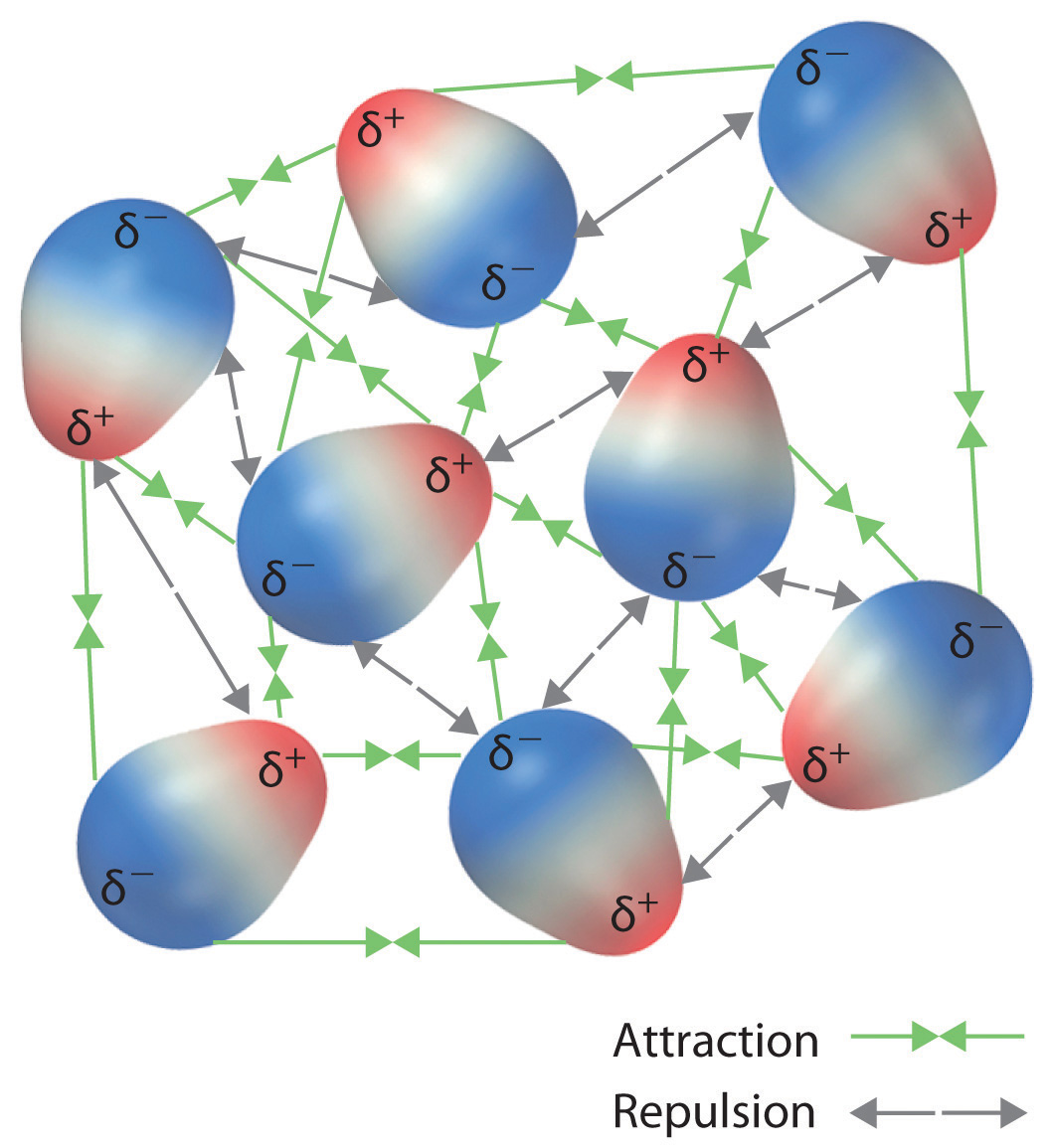
Because each end of a dipole possesses only a fraction of the charge of an electron, dipole–dipole interactions are substantially weaker than the interactions between 2 ions, each of which has a accuse of at least ±1, or between a dipole and an ion, in which one of the species has at least a total positive or negative charge. In addition, the attractive interaction betwixt dipoles falls off much more apace with increasing distance than do the ion–ion interactions. Recall that the attractive free energy betwixt ii ions is proportional to ane/r, where r is the distance between the ions. Doubling the distance (r → 2r) decreases the attractive energy past ane-half. In contrast, the energy of the interaction of two dipoles is proportional to i/r 3, so doubling the distance betwixt the dipoles decreases the strength of the interaction by twothree, or 8-fold. Thus a substance such as \(\ce{HCl}\), which is partially held together past dipole–dipole interactions, is a gas at room temperature and 1 atm pressure. Conversely, \(\ce{NaCl}\), which is held together by interionic interactions, is a high-melting-point solid. Within a series of compounds of similar molar mass, the strength of the intermolecular interactions increases equally the dipole moment of the molecules increases, every bit shown in Table \(\PageIndex{1}\).
| Compound | Molar Mass (g/mol) | Dipole Moment (D) | Humid Point (K) |
|---|---|---|---|
| C3Hhalf-dozen (cyclopropane) | 42 | 0 | 240 |
| CHiiiOCH3 (dimethyl ether) | 46 | 1.30 | 248 |
| CH3CN (acetonitrile) | 41 | 3.nine | 355 |
The attractive free energy between two ions is proportional to i/r, whereas the attractive free energy betwixt two dipoles is proportional to 1/r6.
Video Discussing Dipole Intermolecular Forces. Source: https://youtu.be/ACq_95SIBck
Example \(\PageIndex{ane}\)
Adapt ethyl methyl ether (CHiiiOCH2CH3), 2-methylpropane [isobutane, (CH3)2CHCH3], and acetone (CHthreeCOCH3) in order of increasing boiling points. Their structures are as follows:
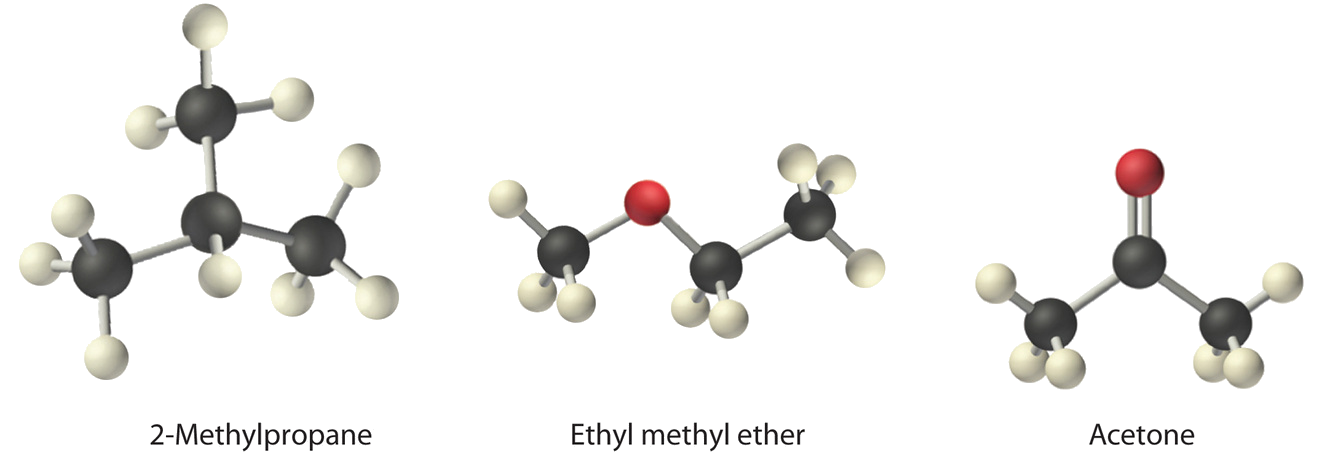
Given: compounds.
Asked for: guild of increasing boiling points.
Strategy:
Compare the molar masses and the polarities of the compounds. Compounds with higher tooth masses and that are polar will have the highest humid points.
Solution:
The three compounds accept essentially the same tooth mass (58–lx g/mol), and then nosotros must look at differences in polarity to predict the strength of the intermolecular dipole–dipole interactions and thus the boiling points of the compounds.
The showtime compound, ii-methylpropane, contains simply C–H bonds, which are non very polar because C and H have like electronegativities. It should therefore have a very modest (but nonzero) dipole moment and a very low boiling point.
Ethyl methyl ether has a structure like to H2O; it contains two polar C–O unmarried bonds oriented at virtually a 109° bending to each other, in addition to relatively nonpolar C–H bonds. Equally a consequence, the C–O bail dipoles partially reinforce one another and generate a pregnant dipole moment that should give a moderately high boiling point.
Acetone contains a polar C=O double bond oriented at nearly 120° to two methyl groups with nonpolar C–H bonds. The C–O bond dipole therefore corresponds to the molecular dipole, which should result in both a rather large dipole moment and a high boiling signal.
Thus we predict the following society of boiling points:
2-methylpropane < ethyl methyl ether < acetone
This effect is in good understanding with the bodily information: 2-methylpropane, boiling point = −11.7°C, and the dipole moment (μ) = 0.13 D; methyl ethyl ether, boiling point = 7.four°C and μ = 1.17 D; acetone, boiling betoken = 56.1°C and μ = 2.88 D.
Exercise \(\PageIndex{ane}\)
Accommodate carbon tetrafluoride (CF4), ethyl methyl sulfide (CHiiiSC2H5), dimethyl sulfoxide [(CHiii)2Southward=O], and 2-methylbutane [isopentane, (CH3)2CHCH2CHthree] in club of decreasing boiling points.
- Answer
-
dimethyl sulfoxide (boiling point = 189.9°C) > ethyl methyl sulfide (boiling point = 67°C) > 2-methylbutane (humid betoken = 27.eight°C) > carbon tetrafluoride (boiling point = −128°C)
London Dispersion Forces
Thus far, we take considered only interactions between polar molecules. Other factors must be considered to explain why many nonpolar molecules, such as bromine, benzene, and hexane, are liquids at room temperature; why others, such as iodine and naphthalene, are solids. Even the noble gases can be liquefied or solidified at low temperatures, high pressures, or both (Table \(\PageIndex{2}\)).
What kind of bonny forces can exist betwixt nonpolar molecules or atoms? This question was answered by Fritz London (1900–1954), a High german physicist who afterward worked in the U.s.. In 1930, London proposed that temporary fluctuations in the electron distributions inside atoms and nonpolar molecules could outcome in the formation of short-lived instantaneous dipole moments, which produce attractive forces called London dispersion forces between otherwise nonpolar substances.
| Substance | Molar Mass (thou/mol) | Melting Bespeak (°C) | Boiling Point (°C) |
|---|---|---|---|
| Ar | forty | −189.4 | −185.9 |
| Xe | 131 | −111.8 | −108.i |
| Ntwo | 28 | −210 | −195.8 |
| Oii | 32 | −218.viii | −183.0 |
| F2 | 38 | −219.7 | −188.1 |
| Iii | 254 | 113.7 | 184.four |
| CHiv | xvi | −182.five | −161.five |
Consider a pair of adjacent He atoms, for example. On average, the two electrons in each He atom are uniformly distributed around the nucleus. Because the electrons are in constant motion, yet, their distribution in 1 cantlet is likely to be asymmetrical at any given instant, resulting in an instantaneous dipole moment. As shown in part (a) in Figure \(\PageIndex{3}\), the instantaneous dipole moment on 1 atom can interact with the electrons in an adjacent cantlet, pulling them toward the positive end of the instantaneous dipole or repelling them from the negative stop. The net effect is that the outset atom causes the temporary formation of a dipole, called an induced dipole, in the second. Interactions between these temporary dipoles cause atoms to be attracted to one another. These bonny interactions are weak and fall off rapidly with increasing distance. London was able to prove with quantum mechanics that the attractive free energy betwixt molecules due to temporary dipole–induced dipole interactions falls off as ane/r half-dozen. Doubling the distance therefore decreases the attractive energy past 26, or 64-fold.
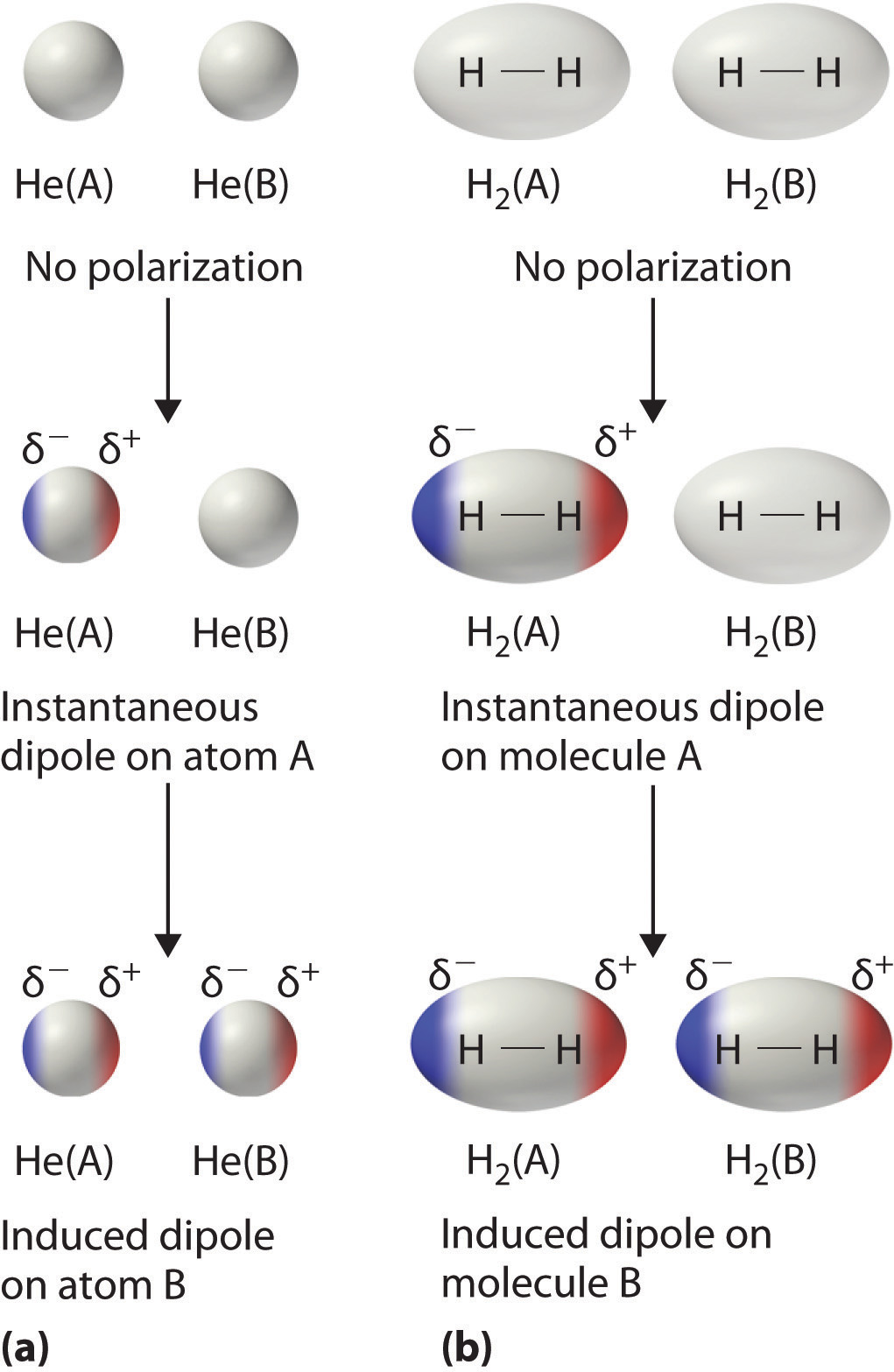
Instantaneous dipole–induced dipole interactions between nonpolar molecules tin produce intermolecular attractions simply every bit they produce interatomic attractions in monatomic substances like Xe. This effect, illustrated for 2 H2 molecules in part (b) in Figure \(\PageIndex{3}\), tends to become more pronounced as atomic and molecular masses increase (Table \(\PageIndex{2}\)). For example, Xe boils at −108.1°C, whereas He boils at −269°C. The reason for this tendency is that the strength of London dispersion forces is related to the ease with which the electron distribution in a given atom can be perturbed. In small atoms such as He, the ii 1southward electrons are held close to the nucleus in a very small volume, and electron–electron repulsions are strong enough to forestall significant disproportion in their distribution. In larger atoms such equally Xe, notwithstanding, the outer electrons are much less strongly attracted to the nucleus because of filled intervening shells. As a result, it is relatively like shooting fish in a barrel to temporarily deform the electron distribution to generate an instantaneous or induced dipole. The ease of deformation of the electron distribution in an atom or molecule is chosen its polarizability. Because the electron distribution is more hands perturbed in large, heavy species than in small, low-cal species, we say that heavier substances tend to be much more than polarizable than lighter ones.
For like substances, London dispersion forces get stronger with increasing molecular size.
The polarizability of a substance also determines how it interacts with ions and species that possess permanent dipoles. Thus, London dispersion forces are responsible for the general trend toward higher boiling points with increased molecular mass and greater surface area in a homologous series of compounds, such as the alkanes (part (a) in Figure \(\PageIndex{4}\)). The strengths of London dispersion forces also depend significantly on molecular shape because shape determines how much of one molecule tin can interact with its neighboring molecules at any given fourth dimension. For example, role (b) in Figure \(\PageIndex{4}\) shows ii,2-dimethylpropane (neopentane) and n-pentane, both of which take the empirical formula CfiveH12. Neopentane is almost spherical, with a minor surface area for intermolecular interactions, whereas n-pentane has an extended conformation that enables it to come up into close contact with other n-pentane molecules. As a result, the humid point of neopentane (9.five°C) is more than than 25°C lower than the boiling bespeak of northward-pentane (36.1°C).
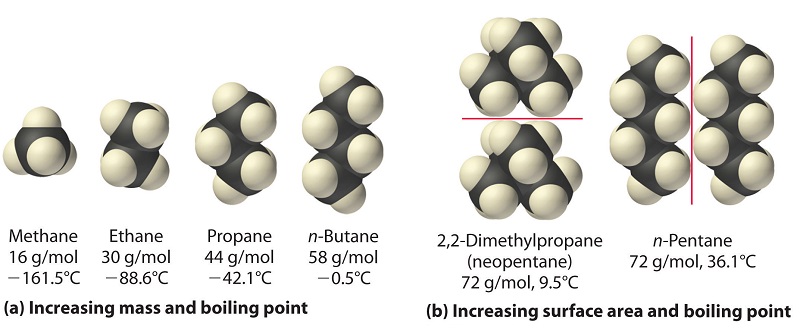
All molecules, whether polar or nonpolar, are attracted to 1 another by London dispersion forces in addition to any other attractive forces that may exist present. In general, however, dipole–dipole interactions in small polar molecules are significantly stronger than London dispersion forces, so the former predominate.
Video Discussing London/Dispersion Intermolecular Forces. Source: https://youtu.exist/RCRTcIEQ-Hk
Example \(\PageIndex{two}\)
Arrange n-butane, propane, 2-methylpropane [isobutene, (CH3)twoCHCH3], and n-pentane in order of increasing boiling points.
Given: compounds
Asked for: lodge of increasing boiling points
Strategy:
Determine the intermolecular forces in the compounds, and so adapt the compounds co-ordinate to the force of those forces. The substance with the weakest forces will take the lowest boiling point.
Solution:
The four compounds are alkanes and nonpolar, and so London dispersion forces are the only of import intermolecular forces. These forces are by and large stronger with increasing molecular mass, so propane should have the everyman humid point and north-pentane should have the highest, with the two butane isomers falling in betwixt. Of the ii butane isomers, 2-methylpropane is more than compact, and due north-butane has the more extended shape. Consequently, we expect intermolecular interactions for n-butane to be stronger due to its larger surface expanse, resulting in a higher boiling betoken. The overall club is thus every bit follows, with actual boiling points in parentheses: propane (−42.ane°C) < 2-methylpropane (−11.7°C) < n-butane (−0.5°C) < n-pentane (36.1°C).
Exercise \(\PageIndex{2}\)
Arrange GeHiv, SiClfour, SiH4, CH4, and GeCl4 in club of decreasing boiling points.
- Answer
-
GeCliv (87°C) > SiCl4 (57.6°C) > GeH4 (−88.v°C) > SiH4 (−111.8°C) > CHfour (−161°C)
Hydrogen Bonds
Molecules with hydrogen atoms bonded to electronegative atoms such every bit O, N, and F (and to a much bottom extent, Cl and S) tend to exhibit unusually stiff intermolecular interactions. These outcome in much higher boiling points than are observed for substances in which London dispersion forces boss, equally illustrated for the covalent hydrides of elements of groups 14–17 in Figure \(\PageIndex{5}\). Methane and its heavier congeners in group xiv grade a series whose boiling points increase smoothly with increasing molar mass. This is the expected tendency in nonpolar molecules, for which London dispersion forces are the exclusive intermolecular forces. In contrast, the hydrides of the lightest members of groups 15–17 accept boiling points that are more than 100°C greater than predicted on the basis of their molar masses. The effect is most dramatic for h2o: if we extend the directly line connecting the points for HtwoTe and H2Se to the line for catamenia 2, nosotros obtain an estimated boiling point of −130°C for water! Imagine the implications for life on Globe if water boiled at −130°C rather than 100°C.
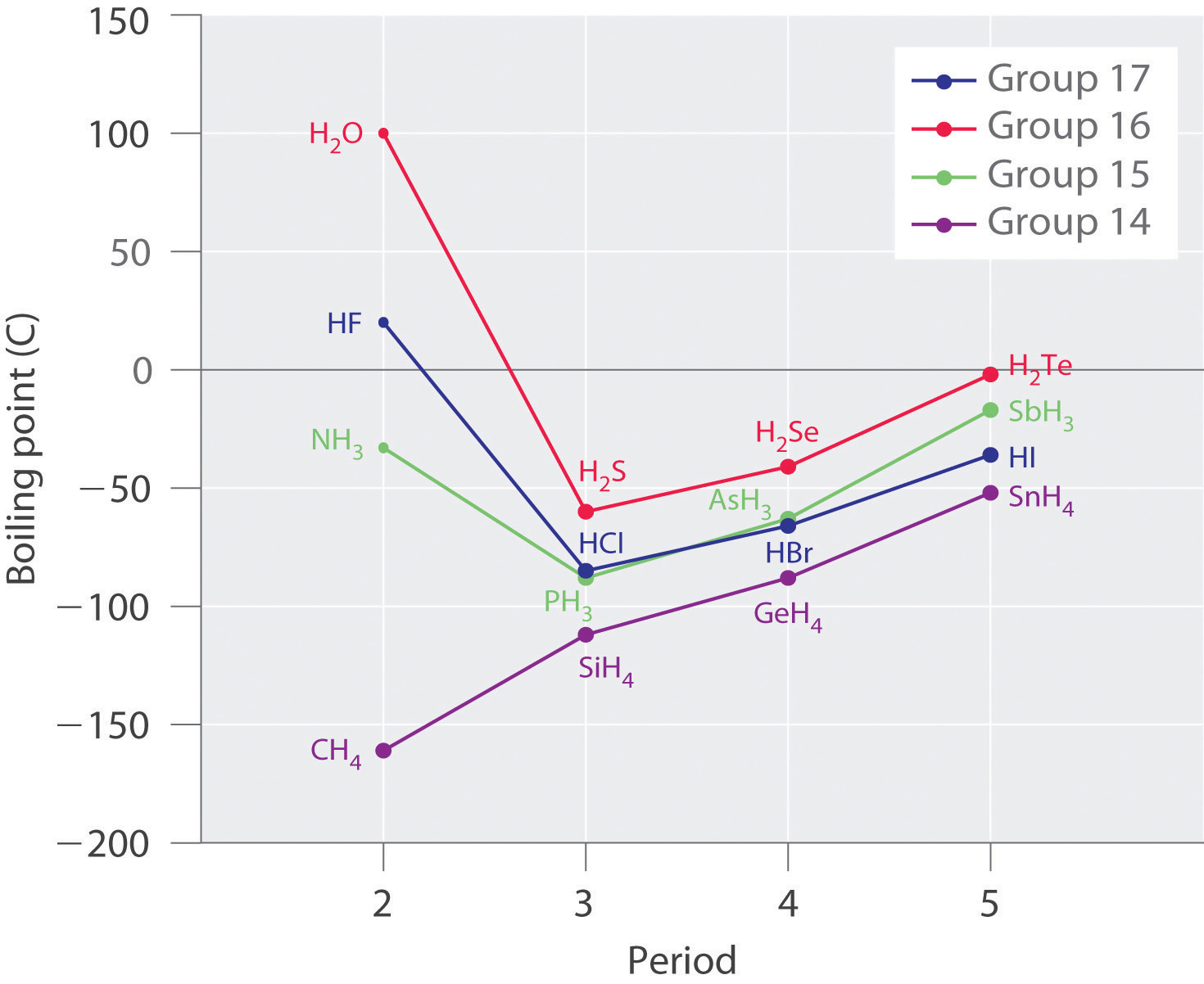
Why do strong intermolecular forces produce such anomalously high boiling points and other unusual backdrop, such as loftier enthalpies of vaporization and high melting points? The reply lies in the highly polar nature of the bonds between hydrogen and very electronegative elements such equally O, N, and F. The large departure in electronegativity results in a large partial positive accuse on hydrogen and a correspondingly large fractional negative charge on the O, N, or F atom. Consequently, H–O, H–Due north, and H–F bonds take very large bail dipoles that can interact strongly with 1 another. Considering a hydrogen atom is and so small, these dipoles can as well approach one another more closely than near other dipoles. The combination of large bail dipoles and short dipole–dipole distances results in very potent dipole–dipole interactions chosen hydrogen bonds, as shown for ice in Effigy \(\PageIndex{6}\). A hydrogen bond is usually indicated by a dotted line between the hydrogen atom fastened to O, N, or F (the hydrogen bond donor) and the atom that has the lone pair of electrons (the hydrogen bail acceptor). Because each water molecule contains two hydrogen atoms and two lone pairs, a tetrahedral organization maximizes the number of hydrogen bonds that can be formed. In the structure of water ice, each oxygen atom is surrounded past a distorted tetrahedron of hydrogen atoms that grade bridges to the oxygen atoms of adjacent water molecules. The bridging hydrogen atoms are not equidistant from the two oxygen atoms they connect, notwithstanding. Instead, each hydrogen atom is 101 pm from one oxygen and 174 pm from the other. In contrast, each oxygen atom is bonded to two H atoms at the shorter distance and two at the longer distance, respective to 2 O–H covalent bonds and two O⋅⋅⋅H hydrogen bonds from adjacent water molecules, respectively. The resulting open, cagelike structure of ice means that the solid is actually slightly less dense than the liquid, which explains why ice floats on h2o, rather than sinks.
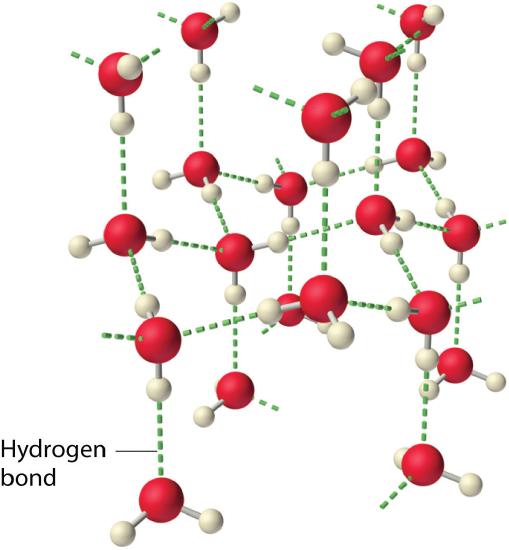
Each water molecule accepts two hydrogen bonds from two other water molecules and donates two hydrogen atoms to course hydrogen bonds with ii more water molecules, producing an open up, cagelike structure. The structure of liquid water is very similar, but in the liquid, the hydrogen bonds are continually broken and formed because of rapid molecular motion.
Hydrogen bond germination requires both a hydrogen bond donor and a hydrogen bond acceptor.
Because ice is less dumbo than liquid water, rivers, lakes, and oceans freeze from the top down. In fact, the water ice forms a protective surface layer that insulates the residuum of the h2o, assuasive fish and other organisms to survive in the lower levels of a frozen lake or bounding main. If ice were denser than the liquid, the ice formed at the surface in cold weather would sink equally fast as it formed. Bodies of water would freeze from the bottom upwards, which would be lethal for most aquatic creatures. The expansion of water when freezing also explains why automobile or gunkhole engines must be protected by "antifreeze" and why unprotected pipes in houses suspension if they are immune to freeze.
Video Discussing Hydrogen Bonding Intermolecular Forces. Source: https://youtu.be/92rbjSpHbr0
Example \(\PageIndex{3}\)
Considering CHiiiOH, CiiH6, Xe, and (CH3)3N, which tin can form hydrogen bonds with themselves? Draw the hydrogen-bonded structures.
Given: compounds
Asked for: formation of hydrogen bonds and structure
Strategy:
- Identify the compounds with a hydrogen cantlet attached to O, Northward, or F. These are likely to exist able to act equally hydrogen bond donors.
- Of the compounds that tin can deed as hydrogen bail donors, identify those that also contain lone pairs of electrons, which let them to be hydrogen bail acceptors. If a substance is both a hydrogen donor and a hydrogen bond acceptor, draw a structure showing the hydrogen bonding.
Solution:
A. Of the species listed, xenon (Xe), ethane (C2H6), and trimethylamine [(CHthree)3N] practice not contain a hydrogen atom fastened to O, Northward, or F; hence they cannot act as hydrogen bail donors.
B. The one compound that can human activity every bit a hydrogen bond donor, methanol (CH3OH), contains both a hydrogen atom fastened to O (making it a hydrogen bond donor) and 2 solitary pairs of electrons on O (making information technology a hydrogen bail acceptor); methanol can thus form hydrogen bonds by acting as either a hydrogen bail donor or a hydrogen bond acceptor. The hydrogen-bonded construction of methanol is as follows:
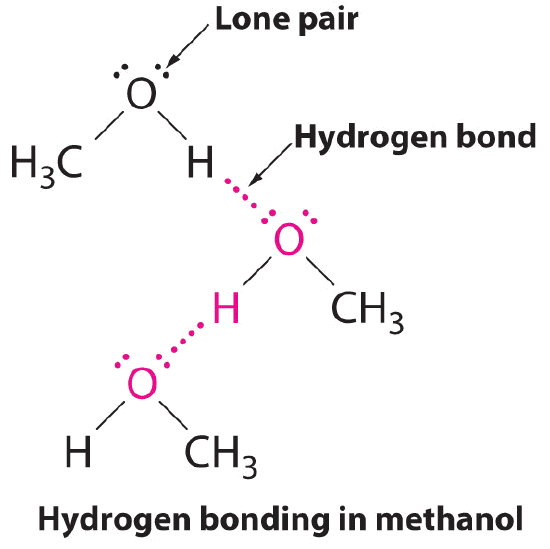
Exercise \(\PageIndex{3}\)
Considering CHiiiCOiiH, (CH3)iiiN, NH3, and CHiiiF, which tin form hydrogen bonds with themselves? Depict the hydrogen-bonded structures.
- Answer
-
CH3COiiH and NHthree;

Although hydrogen bonds are significantly weaker than covalent bonds, with typical dissociation energies of only 15–25 kJ/mol, they have a significant influence on the concrete properties of a compound. Compounds such equally HF can form simply ii hydrogen bonds at a time equally can, on average, pure liquid NH3. Consequently, fifty-fifty though their molecular masses are like to that of water, their boiling points are significantly lower than the humid point of water, which forms four hydrogen bonds at a time.
Instance \(\PageIndex{4}\): Buckyballs
Arrange C60 (buckminsterfullerene, which has a cage structure), NaCl, He, Ar, and N2O in social club of increasing boiling points.
Given: compounds.
Asked for: order of increasing boiling points.
Strategy:
Identify the intermolecular forces in each compound and and so arrange the compounds co-ordinate to the forcefulness of those forces. The substance with the weakest forces volition have the lowest boiling bespeak.
Solution:
Electrostatic interactions are strongest for an ionic compound, so nosotros expect NaCl to accept the highest boiling point. To predict the relative boiling points of the other compounds, we must consider their polarity (for dipole–dipole interactions), their ability to grade hydrogen bonds, and their molar mass (for London dispersion forces). Helium is nonpolar and by far the lightest, and so it should take the lowest boiling point. Argon and N2O have very similar molar masses (40 and 44 g/mol, respectively), just Northward2O is polar while Ar is not. Consequently, NorthiiO should accept a higher boiling point. A Csixty molecule is nonpolar, but its molar mass is 720 chiliad/mol, much greater than that of Ar or Due northtwoO. Because the boiling points of nonpolar substances increase rapidly with molecular mass, C60 should boil at a higher temperature than the other nonionic substances. The predicted guild is thus as follows, with bodily boiling points in parentheses:
He (−269°C) < Ar (−185.7°C) < Northward2O (−88.5°C) < C60 (>280°C) < NaCl (1465°C).
Exercise \(\PageIndex{4}\)
Accommodate 2,4-dimethylheptane, Ne, CS2, Clii, and KBr in order of decreasing boiling points.
- Reply
-
KBr (1435°C) > 2,4-dimethylheptane (132.9°C) > CS2 (46.6°C) > Cl2 (−34.6°C) > Ne (−246°C)
Example \(\PageIndex{v}\):
Identify the most meaning intermolecular force in each substance.
- C 3 H 8
- CH 3 OH
- H 2 S
Solution
a. Although C–H bonds are polar, they are but minimally polar. The most pregnant intermolecular force for this substance would exist dispersion forces.
b. This molecule has an H atom bonded to an O atom, so information technology volition experience hydrogen bonding.
c. Although this molecule does not experience hydrogen bonding, the Lewis electron dot diagram and VSEPR indicate that it is aptitude, so information technology has a permanent dipole. The about significant force in this substance is dipole-dipole interaction.
Exercise \(\PageIndex{6}\)
Identify the most significant intermolecular force in each substance.
- HF
- HCl
- Answer a
-
hydrogen bonding
- Respond b
-
dipole-dipole interactions
Summary
Intermolecular forces are electrostatic in nature and include van der Waals forces and hydrogen bonds. Molecules in liquids are held to other molecules by intermolecular interactions, which are weaker than the intramolecular interactions that concord the atoms together within molecules and polyatomic ions. Transitions betwixt the solid and liquid, or the liquid and gas phases, are due to changes in intermolecular interactions, simply do not affect intramolecular interactions. The 3 major types of intermolecular interactions are dipole–dipole interactions, London dispersion forces (these two are ofttimes referred to collectively as van der Waals forces), and hydrogen bonds. Dipole–dipole interactions arise from the electrostatic interactions of the positive and negative ends of molecules with permanent dipole moments; their strength is proportional to the magnitude of the dipole moment and to 1/rthree , where r is the altitude between dipoles. London dispersion forces are due to the formation of instantaneous dipole moments in polar or nonpolar molecules as a result of short-lived fluctuations of electron charge distribution, which in turn cause the temporary formation of an induced dipole in adjacent molecules; their free energy falls off as 1/r 6. Larger atoms tend to be more polarizable than smaller ones, because their outer electrons are less tightly jump and are therefore more easily perturbed. Hydrogen bonds are especially strong dipole–dipole interactions between molecules that have hydrogen bonded to a highly electronegative cantlet, such as O, N, or F. The resulting partially positively charged H atom on ane molecule (the hydrogen bond donor) can interact strongly with a lone pair of electrons of a partially negatively charged O, Northward, or F atom on adjacent molecules (the hydrogen bond acceptor). Because of stiff O⋅⋅⋅H hydrogen bonding between water molecules, h2o has an unusually loftier boiling point, and ice has an open, cagelike structure that is less dense than liquid water.
Source: https://chem.libretexts.org/Bookshelves/General_Chemistry/Map%3A_Chemistry_-_The_Central_Science_(Brown_et_al.)/11%3A_Liquids_and_Intermolecular_Forces/11.2%3A_Intermolecular_Forces
0 Response to "Ï»¿tell Us What You Know About the Intermolecular Forces in Water."
Post a Comment